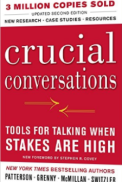As Safety finds itself often outside of line management and ‘advising’ we have very little legitimate power to direct teams and individuals that work with us.
Safety is often criticised for not having skin in the game in this regard, and only imparting information, rather than having to follow through. Personally, I treat the difference between informing line management and them taking action as my responsibility to influence as per tenants of Extreme Ownership [Source]
Typically this isn’t even considered a skill, much to people’s detriment. I’ve discussed it frequently with other Safety people and it seems the overwhelming majority have a fixed mindset in relation to it. You either have it or you don’t. I’d like to challenge that today and give one resource which you can use to improve yourself. To me, the ability to influence is one of the best indicators when I interview people and watch them infield as to timeline of their trajectory into larger or more senior roles. You want to get ahead, start levelling up in influencing!
The resource is a book (you can do some online courses now as well, if you want a bit of paper), and will help you:
- Craft & frame your message in a manner which will get you last initial rejection of the anchor of the status quo
- Identify the right ear (influential person with leverage) which needs to hear your message and the importance of crafting unique messages for different ears
- Identifying times where individuals will be in the right frame to receive a message
- Eliminating or minimising the other persons feelings of violation of psychological safety
- Craft environments and engineer conversations which respectfully challenge peoples assumptions to move an issue forward.
The book is Crucial Conversations, which some of you may have read or at least feel like you have read after participating in safety leadership or behavioural based safety initiatives.  I read it on my second project as a Safety Advisor and it was immensely helpful in improving the relationships I had on the Project as well as allowing me to expand my circle of influence with my new found (and heavily practised and iterated!) skill.
I read it on my second project as a Safety Advisor and it was immensely helpful in improving the relationships I had on the Project as well as allowing me to expand my circle of influence with my new found (and heavily practised and iterated!) skill.
I was also involved in implementing a high-performance framework which used the principles and techniques of Crucial Conversations to improve the psychological safety within teams (including senior teams). It’s one process which attempts to balance the psychological safety ledger by acknowledging that individuals within a team have a role to play in improving psychological safety as well, rather than solely placing it on the shoulders of leaders.
It’s not a hard read (great on a flight or on the commute to work, not a uni research paper) and guarantee if you scribble in books like me, you will easily find a heap to highlight, underline and circle.
 I’ve reread it a number of times when I haven’t been as successful influencing someone as I would have liked, and it’s also great as a reminder or fixed coach you can refer back to.
I’ve reread it a number of times when I haven’t been as successful influencing someone as I would have liked, and it’s also great as a reminder or fixed coach you can refer back to.
So if you are predominantly in a technical role or looking to take that next step, would thoroughly recommend investing the small amount in yourself, buy the book, reflect and put the principles into practice.